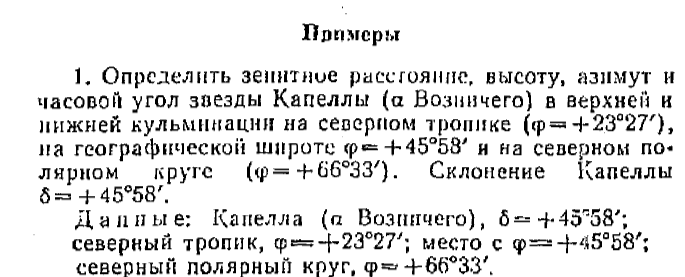You are missing trading opportunities:
- Free trading apps
- Over 8,000 signals for copying
- Economic news for exploring financial markets
Registration
Log in
You agree to website policy and terms of use
If you do not have an account, please register
М. M. Dagaev. Sbornik Zadacha po AS'l'RONOMIY (1980).
MDagaevSbornikZadacPoAstronomii.pdf - Yandex.Documents (yandex.ru)
1.
2.
3.
4.
I don't know if it's worth trying to assign these tasks to ChatGPT.
There are HUNDREDS more tasks on various topics in the book.
Well and lastly, for full understanding of the volume of scientific knowledge on Astronomy (from the list of hundreds of books, articles, researches given on the previous page):
Gravity, Neutrinos and the Universe. year of issue: 1962 Author: J. Wheeler. genre: Popular Science.
Problems of Physics - J. Wheeler - Gravitation, Neutrinos and the Universe. [1962,DjVu,RUS] :: RuTracker.org
Gorbatsky V.G. Space Gas Dynamics. M.: Nauka, 1977
A few pages from the book.
Find the hour angles of the stars Castor (alpha Gemini) and Sheath (beta Pegasus) when the hour angle of the star Vega (alpha Lyra) is 4 hours 15 minutes and 10 seconds. The direct ascension of Castor is 7 hours 31 minutes and 25 seconds, Vega 18 hours 35 minutes and 15 seconds and Sheath 23 hours 01 minutes and 21 seconds.
...
!
In order to find the hour angles of the stars Castor and Sheath, we need to calculate their direct ascension at the moment when the hour angle of the star Vega is 4 hours 15 minutes and 10 seconds.
To do this, we can use the hour angle formula:
hour angle = sidereal time - right ascension
where sidereal time is the sidereal time at the moment of observation, and right ascension is the direct ascension of the star expressed in hours.
To find the sidereal time we need
The next attempt was better, but ended with the same result:
Find the hour angles of the stars Castor (alpha Gemini) and Sheath (beta Pegasus) at the time when the hour angle of the star Vega (alpha Lyra) is 4 hours 15 minutes and 10 seconds. The direct ascension of Castor is 7 hours 31 minutes and 25 seconds, Vega 18 hours 35 minutes and 15 seconds and Sheath 23 hours 01 minutes and 21 seconds.
...
!
The hour angle of a star is calculated as the difference between the local mean time and the direct ascension of the star. In order to find the hour angle of the star Vega at the time when it is 4 hours 15 minutes and 10 seconds, we need to calculate the local mean time at that moment.
The local mean time can be found by knowing the difference between the zonal time and the longitude of the place of observation. For this example, let's assume that the observation site is in the eastern part of the United States (in the EST zone), then the zonal time will be UTC-5 hours. Let's also assume that the longitude of the observation site is 75 degrees West.
To find the local mean time, we must add or subtract 4 minutes for each degree of longitude from the zonal time. In our case, we must subtract 75*4=300 minutes, or 5 hours, from the zonal time.
Thus, the local mean time at the time when Vega's hour angle is 4 hours 15 minutes and 10 seconds will be 4:15:10 - 5:00 = -0:44:50 (minus 44 minutes and 50 seconds).
To find the hour angle of Castor and Sheath at this point, we can use the following formula:
Hour Angle = (local mean time - direct ascent) * 15 degrees/hour
For Castor:
Castor hour angle = (-0:44:50 - 7:31:25) * 15
Attempt number 3. Sad.
Find the hour angles of the stars Castor (alpha Gemini) and Sheath (beta Pegasus) at the moment when the hour angle of the star Vega (alpha Lyra) is 4 hours 15 minutes and 10 seconds. The direct ascension of Castor is 7 hours 31 minutes and 25 seconds, Vega 18 hours 35 minutes and 15 seconds and Sheath 23 hours 01 minutes and 21 seconds.
...
!
The hour angle for a star can be found using its direct ascension and the observer's local sidereal time (LST). The LST depends on the observer's location and the time of day. For this case, to find the LST, we need to know the difference between local time and Greenwich Mean Time.
The local time can be determined by knowing the hour angle of the star Vega and the latitude.
I almost fell off my chair when I asked the chat room for the code of getting floating profit by API for one of the trading platforms.
The chat room gave me the code of the programme and explained step by step what to do.
It amazed me, it made my hair stand on end.... But it turned out that the chat made up the code. When I asked if the chat was sure of the answer because the specified methods in the API did not exist, the chat was not embarrassed, apologised, and immediately invented a new code with non-existent API methods and detailed instructions on how to use it.
Amazing technology!